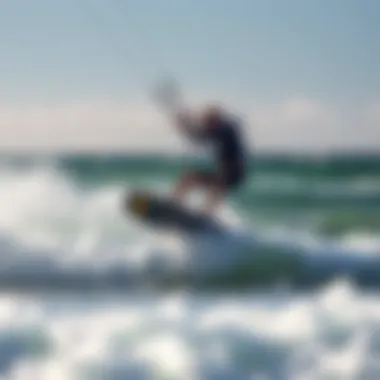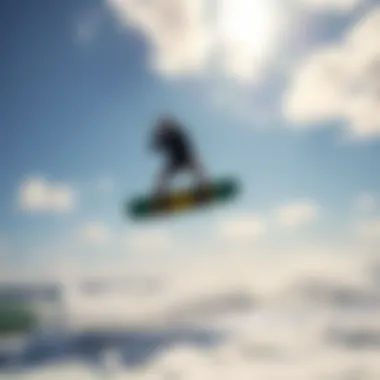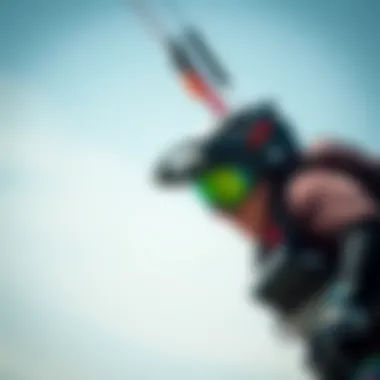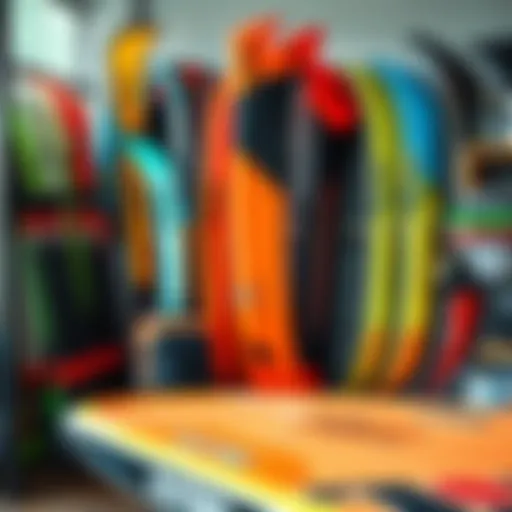Freeride vs Freestyle: Key Differences in Kiteboarding


Intro
Kiteboarding, a sport that dances on the fine line between thrill and skill, is host to various styles that cater to different tastes and abilities. Among these, freeride and freestyle kiteboarding reign as two of the most popular choices, each offering unique experiences and challenges. With the wind as your companion and the waves below forming a natural playground, understanding these distinct styles is crucial for practitioners—new and seasoned alike.
Freeride kiteboarding emphasizes smooth sailing, focused on enjoyment and exploration out on the water. Here, the aim is to cruise with grace, enjoying long runs and the feeling of liberation as one glides effortlessly over the sea. In contrast, freestyle kiteboarding is a realm full of somersaults and tricks, where the rider's creativity takes center stage amidst gravity-defying maneuvers. For those seeking to add flair and impress, freestyle becomes the calling.
By diving into the gears, techniques, and nuances of both styles, this guide will clarify your choices and help you navigate the exciting world of kiteboarding. Whether you're just dipping your toes into the sport or carving out your identity as a kiteboarder, understanding the ropes will enhance both your skills and your appreciation for these distinctive styles.
Foreword to Kiteboarding
Kiteboarding, a sport that gracefully melds wind, water, and skill, has grown into a vibrant community cherished by outdoor enthusiasts around the globe. This article seeks to peel back the layers of two distinct styles within the sport—freeride and freestyle. Understanding these styles is not just beneficial for those venturing into kiteboarding; it is also vital for seasoned riders looking to refine their technique or transition between styles.
The significance of distinguishing between freeride and freestyle kiteboarding cannot be overstated. Each style offers unique challenges and rewards, ultimately shaping one's experience on the water. As we delve deeper, we will unpack these differences, providing the tools and insights necessary for riders to find their niche within the sport.
Historical Context
To truly appreciate kiteboarding today, it’s essential to glance back at its origins. The roots of kiteboarding can be traced back to as early as the 12th century, with early designs crafted for utilitarian purposes, primarily in Asia. However, it wasn’t until innovations in material science and design during the late 20th century that the sport began to take its modern form. A pivotal moment came in 1985 when the first hybrid kiteboards were created, marking the dawn of a new age for this exhilarating activity. As advancements were made—whether it was in the design of kites themselves or the introduction of rapid-release harness systems—riders began to explore various styles and techniques, which eventually evolved into the distinct freeride and freestyle forms we know today.
This historical perspective is not just a footnote; it lays the foundation for understanding how past innovations inform current practices in kiteboarding. The evolution of styles mirrors technological advances within the sport, revealing a fascinating interplay of human ingenuity and adventure.
Significance of Styles
Identifying each style is crucial because they cater to diverse preferences and skill levels among kiteboarders. Freeride kiteboarding emphasizes smooth, fluid motion across the water, focusing on riding the wind’s natural currents rather than executing acrobatics. This style is perfect for those who wish to embrace the thrill of gliding with speed while taking in the beauty of the surroundings. In contrast, freestyle kiteboarding embraces a more adrenaline-fueled approach. Riders engage in jumps, spins, and dynamic tricks, showcasing their creativity and athleticism in the process.
The choice of style can significantly impact the rider's journey, influencing everything from equipment selection to the type of kiteboarding community one becomes part of. By exploring these distinct paths, riders can not only improve their skills but also deepen their appreciation for the sport as a whole. Ultimately, understanding the significance of styles in kiteboarding invites riders to think critically about their motivations and goals, challenging them to explore new horizons in their kiteboarding experience.
"Every kiteboarder brings their own unique flair to the sport. By understanding the nuances between freeride and freestyle, one can unlock new dimensions of enjoyment and skill."
Defining Freeride Kiteboarding
Freeride kiteboarding stands as one of the most accessible and versatile styles within the sport, offering riders a unique platform to embrace the beauty of the water and wind. Rather than being constrained by strict rules or technical requirements, freeride allows kiteboarders to express their individuality through the art of riding. Understanding this style goes beyond just the basic movements; it’s about grasping the freedom and thrill it embodies.
Characteristics of Freeride
The essence of freeride kiteboarding is its emphasis on fluidity and personal expression. Here are some core characteristics:
- Versatility: Freeride encompasses a broad range of terrains and conditions. Be it flat water, small waves, or choppy seas, riders adapt and thrive.
- Non-competitive Nature: Unlike freestyle, which often focuses on performing tricks in a competitive environment, freeride is more about enjoying the moment and savoring the ride. The mantra here is less about showing off and more about finding personal joy on the water.
- Smooth Transitions: Riders typically navigate through smooth carve turns and effortless jumps. The focus is on maintaining speed and control while enjoying the ride.
These characteristics grant a sense of freedom that resonates with many kiteboarders, making it an ideal choice for both beginners and seasoned pros looking to unwind.
Ideal Conditions for Freeride
Finding the right conditions is crucial for optimizing the freeride experience. Typically, ideal conditions include:
- Wind Conditions: Moderate winds of about 12-20 knots are usually most favorable. These wind speeds allow for smooth riding without overwhelming the kiter.
- Water Surface: Flat water is preferred as it enhances the ease of transitioning and jumping. However, choppy conditions can also be thrilling, allowing for a different type of ride.
- Weather: Sunny days often improve the riding experience, providing better visibility and a generally enjoyable atmosphere.
The flexibility in conditions is what adds to the appeal of freeride kiteboarding. Riders often find themselves seeking out new spots and embracing the distinct challenges each environment offers.
Equipment Essentials
To fully embrace freeride kiteboarding, a few key pieces of equipment stand out. Understanding this gear is essential for anyone looking to get into the style.
- Kite Type: Most riders prefer all-around kites that offer stability and easy handling. Brands like Naish, North Kiteboarding, and Slingshot offer various options suited for freeride.
- Board Selection: A lighter board with a decent rocker—like a directional or twin-tip—provides optimal performance in diverse conditions. Freeriders often lean toward wider boards for better stability and upwind capability.
- Harness: A comfortable harness is vital for effective energy transfer from the kite to the rider. The choice between a seat harness and a waist harness often comes down to personal preference.
- Safety Gear: It's essential to have a reliable impact vest and helmet. Safety cannot be overlooked; ensuring you have the right gear keeps the fun going without unnecessary risk.


"In freeride kiteboarding, the experience lies in the journey. Embracing the wind and water with the right mindset transforms every ride into a personal adventure."
Thus, understanding the fundamentals of freeride kiteboarding opens doors to a broader appreciation of this thrilling sport. As one delves deeper into the nuances, each ride presents its unique blend of empowerment and freedom.
Examination of Freestyle Kiteboarding
Freestyle kiteboarding represents one of the most dynamic and visually captivating styles within the sport. Unlike freeride, which focuses on smooth, uninterrupted riding, freestyle involves a dance with gravity, where riders perform a variety of tricks and maneuvers that can leave spectators in awe. Understanding freestyle is crucial for those who seek to explore the depths of their abilities and the possibilities that kiteboarding presents.
Core Features
At the heart of freestyle kiteboarding are several core features that distinguish it from other styles. These include:
- Trick variety: Freestyle riders often perform jumps, spins, and flips that showcase their skills. The sheer range of tricks available means that each session can feel like a performance.
- Technical complexity: Many tricks require precise timing, coordination, and a solid understanding of kite control. Riders need to manipulate the kite’s movement in conjunction with their bodily actions, a true blend of aerial dance and skill.
- Style expression: Freestyle is not just about trick execution, but also about expressing one’s individual style. Riders often develop their unique flair that sets them apart, whether it’s through the choice of tricks or their overall riding aesthetic.
In essence, freestyle serves as a canvas for creativity, where the only limit is the rider's imagination and skill.
Best Conditions for Freestyle
Freestyle kiteboarding thrives in specific conditions that enhance the performance and safety of riders. Here are the best scenarios for tackling freestyle:
- Flat water: A smooth surface allows for better control during tricks and reduces the chances of crashes upon landing. The shallower water bodies can be especially suitable, providing extra safety during falls.
- Moderate wind: Freestyle performers often prefer wind speeds between 15-25 knots. Too little wind can leave riders stranded, while excessive wind can be challenging to control, risking safety.
- Wind direction: Side-onshore winds are ideal as they provide the necessary lift for tricks without being too intense. Offshore winds can be risky, leading to complications in returning safely if something goes wrong.
Choosing the right conditions significantly impacts a rider's ability to learn and progress in freestyle kiteboarding.
Key Equipment Choices
The right equipment can make or break a freestyle kiteboarding session. Here’s what to consider:
- Kite type: Freestyle riders often lean towards C-kites or blunt-shaped kites that offer precise control and rapid response. Smaller sizes are preferable for more advanced tricks due to their ability to turn quickly and maintain speed during jumps.
- Board selection: A freestyle board typically has a stiffer flex and a more aggressive rocker line. This design aids in popping off the water easily, an essential element for executing tricks successfully.
- Safety gear: Helmets and impact vests are must-haves. Due to the potential for falls and crashes during maneuvering, protecting one’s head and body is critical in making freestyle a safer experience.
"Investing in the right gear not only enhances performance but also boosts confidence in tackling new tricks."
Without the appropriate equipment, even the most skilled riders may find themselves limited in their performance. Selecting the right tools allows for exploration and advancement in the sport.
In summary, examining freestyle kiteboarding reveals its unique traits and requirements. From understanding its core features to recognizing the best conditions and equipment needed, aspiring freestyle kiteboarders can develop their skills and find personal joy in every trick performed.
Technical Comparisons of Freeride and Freestyle
When it comes to understanding the distinct styles of kiteboarding, delving deep into the technical comparisons between freeride and freestyle is essential. Knowing the intricacies not only enhances your performance but also helps you make a more informed decision about which style to pursue. Both styles present unique elements that cater to different skill sets and preferences, hence examining their characteristics offers valuable insights.
Jumping Techniques
In freeride kiteboarding, jumping is usually more straightforward. Riders focus on getting air by using the power of the wind and the board's edge. The goal is to achieve height and distance rather than performing complicated flips or spins. Techniques involve a strong edge grip and a steady pull from the kite, ensuring a clean lift.
Conversely, in freestyle, jumping techniques are about executing tricks that demonstrate skill and creativity. Think board grabs, spins, or even rotations during the jump. Freestyle kitesurfers often use a technique called the "pop," where they compress and then release their legs to generate lift. This demand for precise timing and technique makes freestyle jumps a bit trickier, pushing athletes to master their moves to effectively link jumps with tricks.
Control and Maneuverability
Control is paramount in both styles, but the approach varies significantly. In freeride, the primary aim is often about cruising and enjoying the ride. Riders seek a setup that allows them to glide smoothly over varying water conditions. They typically want gear that offers predictable handling, stability, and comfort at high speeds.
In contrast, freestyle demands increased maneuverability. Riders must be adept at quick changes in direction and making sharp turns while performing tricks. The kites used in freestyle are designed to respond rapidly to input, allowing for intense aerial maneuvers. This responsiveness can often feel exhilarating but also requires riders to have a heightened sense of awareness and control over both kite and board.
Tricks and Stunts Overview


The trick repertoire is one of the most fascinating aspects that differentiate these two styles. Freerider tricks tend to be less complex, focusing on smooth transitions and flowing movements. Riders often engage in simple jumps and transitions that are visually pleasing but don’t demand the same level of technical execution as freestyle tricks do.
Freestyle tricks, on the other hand, can come in an endless variety. Riders often push the envelope by adding difficult rotations, grabs, and combinations. Learning tricks in freestyle may take a significant amount of practice, involving systematic breakdowns of each move. Common tricks like the "KGB" or "S-bend" showcase the athlete’s ability to combine aerial elevation with skillful handling of the kite and board.
�To fully grasp the techniques of each kiteboarding style, riders are encouraged to train consistently, analyze their moves, and learn from fellow board enthusiasts.
In summary, understanding these technical comparisons in jumping techniques, control, and tricks can guide you in determining the kiteboarding style that aligns best with your abilities and aspirations. Whether you lean towards the freedom of freeride or the showcase of freestyle, recognizing each style's intricacies enhances your overall kiteboarding experience.
Skill Development in Freeride vs Freestyle
When it comes to kiteboarding, the styles of freeride and freestyle each call for their own unique skill sets and development paths. This section delves into the nitty-gritty of how one hones their craft in these two distinct approaches. Whether you're gliding smoothly across the water or performing gravity-defying tricks, understanding the nuances of skill development is vital in choosing the path that resonates with your aspirations.
Learning Curve for Freeride
In freeride kiteboarding, the learning curve is often seen as more gentle compared to its freestyle counterpart. Most beginners can comfortably start exploring this style after getting the basics of kite control down. Here’s what makes that so:
- Focus on Fundamentals: Freeriding prioritizes steady progress as opposed to immediate thrills. Riders learn to navigate the water's surface, gauging wind patterns and understanding the lines of the kite.
- Less Emphasis on Tricks: In contrast to freestyle, which demands intricate tricks and stunts, freeride is all about the ride itself. Once you've mastered the basic skills, every session in the water builds confidence while providing a chance to refine turns and transitions.
- Targeted Gear: Most of the equipment used in freeriding, like directional boards or twin-tips, is more forgiving, allowing new riders to practice comfortably without feeling overwhelmed.
It’s safe to say that a lot of riders feel good about their development when they see themselves progress from struggling with water starts to smooth rides while enjoying the surroundings.
Progression Path in Freestyle
Now, if we shift our focus to freestyle kiteboarding, the journey becomes quite the challenge. Freestyle requires a more structured approach to skill development:
- Complex Tricks: The tricks in freestyle can range from basic jumps to complicated rotations. This demands a good amount of practice and often requires riders to take lessons to master the techniques.
- Specific Training: A dedicated freestyle rider must put in the hours practicing various moves like board spins, handle passes, and unhooked jumps. Unlike freeriding, where you can enjoy the ride continuously, freestyle often requires sessions that feel repetitive yet crucial for muscle memory.
- Equipment Utilization: The choice of gear is pivotal. Freestyle boards, which are usually smaller and lighter, allow greater maneuverability, but they can be trickier to handle. Thus, beginners often need more time to adjust before they can execute tricks seamlessly.
It’s not uncommon for aspiring freestyle enthusiasts to participate in clinics or join local kiteboarding groups to share tips and learn together. Community can act as a strong motivator to keep pushing your limits.
Common Challenges Faced
Regardless of the chosen style, both freeride and freestyle kiteboarding come with their own set of challenges:
- Fear of Falling: Kiteboarders, especially novices, often grapple with the fear of wiping out. This is particularly pronounced in freestyle, where crashes can be more dramatic, resulting from high jumps and complex moves.
- Environmental Factors: Wind conditions can change faster than you can say "kiteboard," making it crucial for riders to adapt quickly. Beginners may find this overwhelming, leading to frustration.
- Physical Demands: Strengthening one's core and improving endurance is vital for both styles. However, the rigorous nature of freestyle training can leave even the most seasoned riders feeling sore the next day.
Ultimately, whether a rider opts for freeride or freestyle, the path to skill development remains an ongoing journey. Progress isn’t always linear, but each experience — both the victories and the challenges — shapes a kiteboarder's adventure.
As you ponder your own journey in kiteboarding, keep these insights in mind. It may just steer you toward the style that fits you best and supports your growth as a kiter.
Personal Preference in Choosing a Style
When it comes to kiteboarding, deciding between freeride and freestyle often leads to a crossroads, where personal inclination plays a pivotal role. Personal preference significantly shapes not only the learning experience but also the enjoyment derived from the sport. The choice between freeride, which emphasizes smooth rides over vast stretches of water, and freestyle, which focuses on executing tricks and stunts, often boils down to what resonates most with an individual’s character and aspirations.
Assessing Individual Goals
In kiteboarding, your ambitions shape the journey. When assessing individual goals, one needs to pinpoint the reasons for taking up the sport in the first place. If the idea of cruising along the water, feeling the wind, and enjoying the scenery appeals to you, freeride might fit your style. It's about the thrill of gliding with minimal interruptions.
Conversely, if the thought of performing gravity-defying maneuvers lights a fire in your enthusiasm, then freestyle is your calling. This style demands rigorous training, focus, and a passion for pushing boundaries.
From the outset, jotting down your goals—whether to participate in competitions, explore new locations, or simply bond with fellow kiteboarders—can provide clarity. Your motivations influence the experiences you prioritize, as well as the gear you invest in.
Community Impact and Social Aspects
The kiteboarding community is rich with camaraderie, skill-sharing, and social gatherings. Each style influences social dynamics in unique ways. Freeriders often find themselves in picturesque locations, enjoying a more laid-back vibe, where the focus lies on collective enjoyment and thrill of the ride. There’s something quintessentially social about carving through waves together, enjoying spontaneous meet-ups.


On the other hand, freestyle kiteboarding cultivates a competitive spirit, often leading to gatherings that are more intense and skill-oriented. Here, kiteboarders share tips, film their sessions, and engage in friendly showdowns. This community aspect can embolden your skillset as you push each other to be better.
A mixed community thrives. Many kiteboarders oscillate between styles depending on the day, wind conditions, or even the company they keep. This fluidity in choice enhances social interactions and ultimately enriches the experience. Engaging with groups on platforms like reddit.com or facebook.com can help navigate these social waters.
Choosing a style is not merely a matter of individual choice; it stands at the intersection of personal goals and community dynamics. As the kite flies, so too will the spirit of adventure lead you on a path shaped by your preferences.
Safety Considerations for Freeride and Freestyle
Engaging in kiteboarding brings with it an exhilarating sense of freedom and adventure, but it’s essential to keep safety at the forefront of any session on the water, whether you are a freeride or freestyle enthusiast. Understanding the specific risks tied to each style can help kiteboarders mitigate potential dangers while boosting their enjoyment of the sport.
Risk Factors in Freeride
The freeride style is often associated with cruising along flat water or small swell, appealing to those who enjoy long-distance riding and smooth transitions. Despite its seemingly benign nature, several risk factors are attached.
- Environmental Elements: Freeriders often favor open water, which can have unpredictable changes. Wind gusts or sudden storms can turn a pleasant outing into a dicey situation very quickly. Riders should always check weather conditions prior to launching.
- Obstacle Awareness: Even in freeriding, obstacles such as rocks, shallow areas, and other watercraft can pose a real hazard. Riders must maintain vigilance and familiarize themselves with their riding area to avoid collisions.
- Equipment Failure: Regular gear inspection is vital. The nature of freeriding often necessitates higher-speed travel than some riders anticipate. This speeds up the likelihood of equipment malfunctions, like line breaks or harness failures, leading to severe consequences.
It’s wise for freeriders to practice emergency maneuvers regularly, such as quick water relaunches, and be knowledgeable about self-rescue techniques.
"A well-prepared kiteboarder is an empowered kiteboarder."
Freestyle Safety Protocols
Freestyle kiteboarding, on the other hand, is all about trickery and performance, placing unique demands on safety protocols. While the pursuit of lofty flips and spins is thrilling, understanding the associated risks is crucial.
- Spot Selection: Freestylers often practice in spots with flat, obstacle-free water. Yet, even in these ideal conditions, it’s important to assess the depth and visible hazards. A solid landing can quickly become tricky in shallow areas.
- Training and Spotters: While riding solo can be exhilarating, it’s advisable to have someone watch out for you, especially when learning new moves. Training alongside experienced kiteboarders also reduces the chance of accidents.
- Personal Protective Equipment (PPE): Wearing a helmet is non-negotiable for freestyle riders. The risk of injury increases significantly with aerial tricks, and headgear can mean the difference between a minor bump and a serious injury.
Freestyle kiteboarders should also engage in progressive training, gradually increasing the difficulty of their tricks while paying heed to proper technique.
In summary, whether freeride or freestyle, kiteboarders must prioritize safety actively. Educating oneself about the environment, maintaining equipment diligently, and utilizing protective gear significantly enhance safety while enjoying this thrilling sport.
For more information on kiteboarding safety, refer to resources available at Kiteboarding Safety, and explore guidelines provided by organizations such as American Kiteboarding Association.
Ending: Selecting Your Style
Choosing between freeride and freestyle kiteboarding isn't just a decision about technique; it's a significant step in defining your own journey in the sport. Both styles offer unique experiences, tailored towards different skill sets, preferences, and even lifestyles. Understanding what each style entails can profoundly influence your enjoyment and progression in kiteboarding.
When you consider freeride, you’re looking at a relaxed style aimed at cruising, exploring wide-open spaces, and enjoying the wind. It's perfect for those who relish freedom on the water and want to carve lines across waves while soaking in the scenery. On the flip side, freestyle is worth considering for those with an itch to push their limits, performing gravity-defying tricks and harnessing the art of precision. It's a discipline that demands commitment and continual skill refinement.
Important elements to ponder include:
- Personal Goals: Think about what you want to achieve. Whether it's the thrill of nailing a new trick or the joy of effortless gliding, your aims will guide your choice.
- Environment: The kind of water conditions and locations available to you can heavily influence your selection. Freeride thrives in open sea, while freestyle often seeks out parks or controlled environments.
- Community and Support: Engaging with a community that shares your preferred style can lead to enriching experiences. Whether that’s camaraderie in freestyle sessions or enjoying group outings in freeride, both aspects foster growth.
Ultimately, picking a kiteboarding style is about aligning your passions with your realities on and off the water. Taking the time to weigh these factors will help in crafting not just a better kiteboarding experience but also a more fulfilling connection to this exhilarating sport.
Final Thoughts
As you consider your options, bear in mind that your chosen style may evolve. There’s no strict division where once you pick one, you can never dabble in the other. Many kiteboarders find joy in transitioning from freeride to freestyle or vice versa as skills develop or interests shift.
It’s essential to nurture a mindset of adaptability, allowing yourself to explore the various facets of kiteboarding. The ocean is expansive and so is the potential for personal growth and preferences within it. As the sport matures, it opens doors to new technologies, techniques, and styles that contribute to the overall richness of the kiteboarding experience.
Future of Kiteboarding Styles
The future of kiteboarding, particularly within the realms of freeride and freestyle, looks promising. As new trends emerge, there is an increasing inclination towards hybrid styles that blend both. Innovative technologies in kite design and board construction are pushing the boundaries of what's possible, leading to mixing tricks and freeride maneuvers seamlessly.
Furthermore, the rise of advanced teaching methods through digital platforms and community forums ensures that enthusiasts can access superior resources. For instance, organizations like IKOA promote kiteboarding education, helping newcomers choose their path while refining the skills of seasoned riders.
As environmental awareness rises, kiteboarders are becoming more conscious about the natural world. There's a growing movement focused on sustainable practices within the sport, which shapes the styles people may adopt moving forward. Navigating a world where gear production, water quality, and ecological impact are considered can subtly influence style preferences.
In summary, whether you lean towards freeride's free-flowing essence or freestyle’s aggressive agenda, the most critical aspect remains enjoying every moment on the water. Aligning your style with personal preferences and environmental conditions will lead to a more enriching kiteboarding experience.















